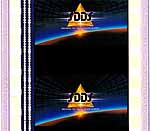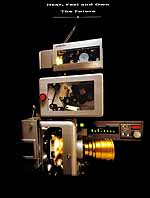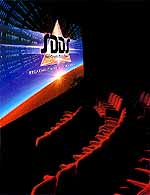 |
The digital data is stored on both
outer edges of the film. This allows for analog track compatibility and for
redundancy should one side have a damaged area. Click on the thumbnail to the left to see a larger version. |
 |
The SDDS Reader is easily installed on top of any
projector, and can piggy-back other sound format readers. In the picture here it is
piggy-backed upon a magnetic reader. Click
on the thumbnail to the left to see a larger version. |
 |
Threading the reader is a breeze. Simply
follow the colored lines! Click on the
thumbnail to the left to see a larger version. |
 |
The SDDS processor is only two rack spaces high,
but it is quite deep. Nevertheless it can usually be accomodated in most racks.
You will usually have to cut another conduit access hole in the rack to accomodate
the heavy duty data cable from the reader. The
processor is positioned immediately before the power amplifiers, after any other sound
processors in the audio chain. Volume and equalization are controlled by the SDDS
processor.
Click on the thumbnail to the left to see a larger version. |
 |
Ok, this is the original SDDS trailer. This,
of course, only sounds the best in a theatre equiped with SDDS sound, but it sounds decent
in MPEG1 stereo on your computer. It is 3.3mb in size and can be played with
Activemovie or any MPEG card. If you have Activemovie, then make sure it is set for
maximum video and audio quality (it usually isn't by default). This trailer is Copyright Sony Corporation.
Click on the thumbnail to the left to download the movie
for viewing. |